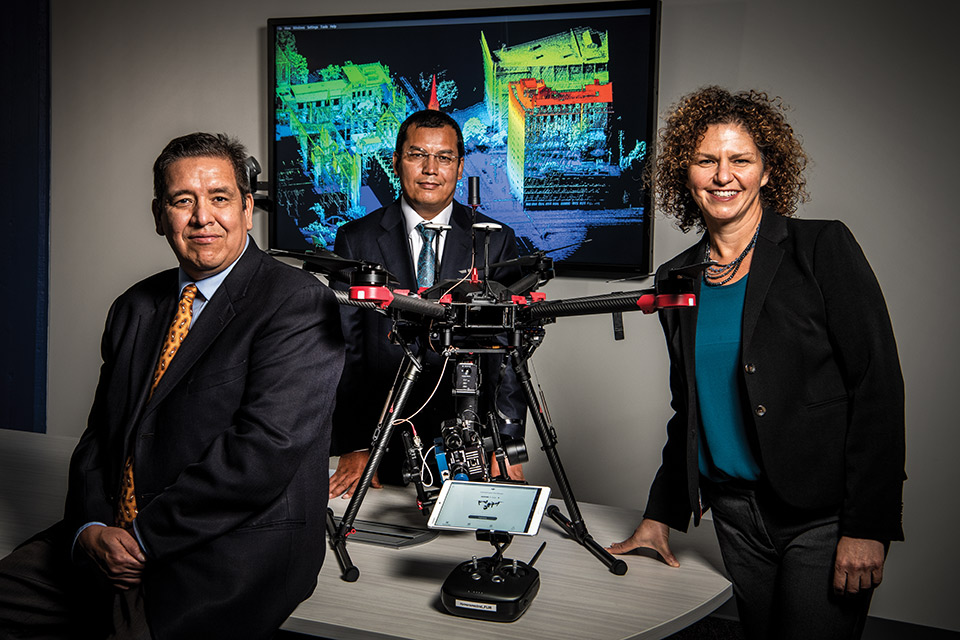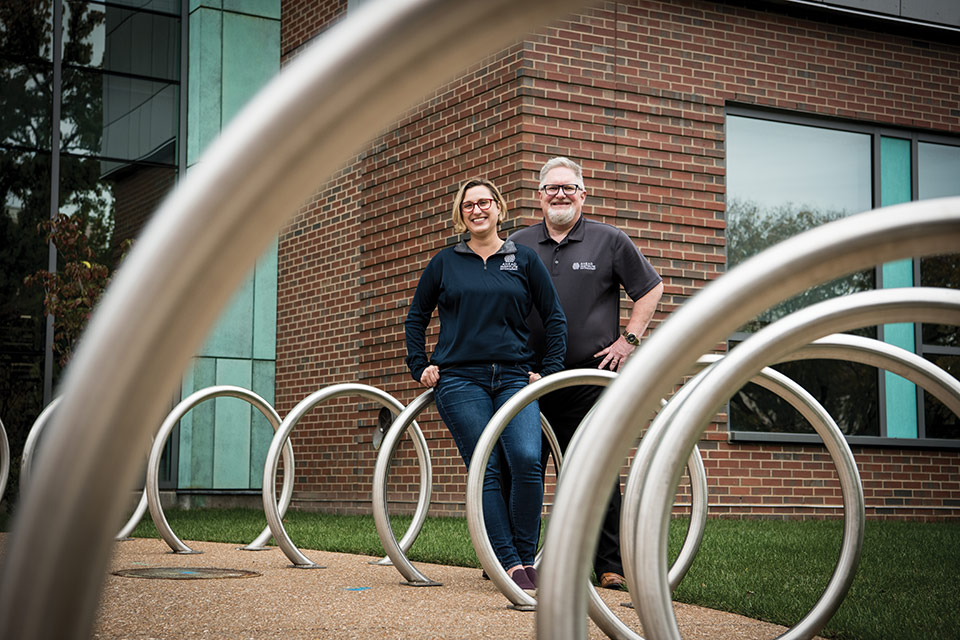Data-Driven Innovation
SLU research institutes leverage data to combat local and global challenges.
Researchers at Saint Louis University continually generate new ideas, paradigms and discoveries. And while news articles on these advances convey outcomes, they rarely shed light on the processes researchers used to identify problems or devise solutions.
Often, the painstaking practice involves sifting through mounds of data, looking for trends, finding patterns and leveraging that information for innovation. Two research institutions established by SLU are accelerating this data-mining process by developing new tools to gather information and novel methods to crunch the scientific data, which researchers are using to predict climate change, track infections and combat the opioid addiction crisis.
The SLU Advanced HEAlth Data (AHEAD) Research Institute and the SLU Geospatial Institute (GeoSLU) were created in 2018 with seed money from the Big Ideas competition designed to foster collaborative projects and cement SLU’s reputation as a destination for training, research and discovery. The institutes also provide undergraduate and graduate students with opportunities to work with researchers and experience the impact of SLU’s research worldwide.
AHEAD
With the shift to electronic medical records (EMR), the amount of digital patient health care data has increased exponentially, and Dr. Jeffrey Scherrer (Grad PH ’04) believes that buried within this data is information that can transform medical care and improve patient care.
Scherrer is senior director of research with SLU’s AHEAD Institute, a comprehensive center for data-driven innovation and research aimed at improving individual and population health. The institute’s multi-disciplinary faculty, doctoral students, and experts in statistics and research methodology help investigators formulate research questions and analyze the massive amounts of data captured in electronic medical records. Data points are de-identified before researchers access them.
AHEAD researchers work with a variety of disciplines and use advanced analytic methods, predictive modeling and machine learning to explore such areas as pediatric otolaryngology, neurological cancers, infection control and hospital readmissions.
Scherrer and his colleagues used analysis of existing data from national data banks to study the prescribing behaviors of physicians before and after the Centers for Disease Control and Prevention issued opioid prescribing guidelines in 2016. By analyzing tens of thousands of electronic health data records across the United States, researchers learned what types of opioids patients were prescribed, why, how long they were prescribed and what types of specialists patients saw.
“Because we had access to existing historical data, we quickly were able to publish
three papers in high-profile journals that documented what was happening,” said Scherrer,
professor of family and community medicine.
“Many studies about provider-prescribing behaviors have relied on surveys and are
limited by social desirability and recall. The information often was biased and not
truly representative. Now, we have real-world information.”
Mining for Research Gold
Scherrer also said access to existing data is a tremendous help for researchers and students who want to explore questions with minimal funding before pursuing larger grants. A SLUCare endocrinologist, for example, suspected patients with lower socioeconomic status did not appear to have the same access to insulin pumps and continuous glucose monitoring as patients with higher insurance status.
The clinician turned to AHEAD experts and learned her observations were more than anecdotal. Nationwide, patients with lower socioeconomic status were not using the diabetes technology as often as other patients. This led to ongoing studies exploring whether the patients with greater access to the tools have better outcomes, and whether physicians are offering the tools, but patients are not using them.
“We’ve collected data for years, but until the last few decades we lacked the capacity to use that data for anything actionable,” said Dr. Leslie Hinyard (Grad PH ’08), associate professor and chairperson of the Department of Health and Clinical Outcomes Research, and director of AHEAD. “We now have the computing power and methods to take health information and use it to understand who is getting access to what care and where, and whether what we’re doing is working, all without collecting new data. It’s more efficient and less expensive.”
Hinyard said no other institute in the St. Louis region offers the comprehensive research infrastructure provided by AHEAD, which is committed to addressing health care issues that disproportionally affect poor and underserved communities. She said AHEAD is primed to be a leader in data analytics because SLU has all the right people in all the right places.
“We have medical school faculty posing the clinical questions, public health faculty with public health expertise, and computer science faculty and students helping us develop the software we need to do what we do,” Hinyard said. “I love that we can work together and analyze existing information to use as a jumping-off point for change.”
The AHEAD Institute was recognized for its scientific excellence when it was invited to join the Health Care Systems Research Network, the nation’s preeminent source of population-based research. This put SLU in the company of approximately 20 other leading health care systems throughout the country, including Kaiser Permanente, Harvard Pilgrim Health Care and the Henry Ford Health Systems. AHEAD also is distinguished by its partnership with the SSM Health system and the SLUCare Physician Group, giving researchers comprehensive, de-identified data about patient care in the Midwest.
GeoSLU
Before COVID-19, it took Dr. Enbal Shacham, professor of public health, a couple of minutes to explain to a layperson her research with geospatial science technology. Now, most people need no explanation. The outbreak demonstrated clearly why location matters when tracking and mitigating an infectious disease.
Shacham is associate director of GeoSLU, which has been in high gear for the past two years using geographic information systems, remote sensing and GPS to create maps and models of the coronavirus outbreak. Information gleaned from geospatial technology fuels the brightly colored dashboards found on websites and television programs with real-time confirmed cases of COVID-19, death rates, hot spots and vaccination rates.
“Geospatial science is invaluable during a pandemic like this,” Shacham said. “We’re able to see human behaviors and patterns like never before. And the data we collect will inform more effective public health directives and keep more people safe.”
GeoSLU researchers have been tracking COVID infection rates in nursing homes and airports, as well as factors related to people’s mobility following the implementation and lifting of stay-at-home orders. They studied mask mandates in five counties in the St Louis region – two with mask mandates, three without. SLU researchers found that infection rates dropped approximately 40% in a six-month period in the counties with the mask mandates compared to the counties without.
Using anonymized cellphone data, SLU researchers also found that when one county closed bars and indoor dining, some people in that county traveled to neighboring countries with no restrictions and spiked infection rates there.
“Previous research was limited to home and work addresses, so public health officials did a lot of guessing and estimating about movement,” Shacham said. “What’s amazing about geospatial science is we can supplement public health knowledge with this non-traditional public health data to better understand the social and physical environments people encounter daily. This leads to better interventions with infectious diseases as well as chronic diseases.”
GeoSLU researchers, for example, are collaborating with an insurance provider in southern California to track air quality in two large counties. Researchers created an algorithm that sends text messages to parents of children with asthma when the air quality is poor and reminds them to have their children carry inhalers or other medications.
Their reach is global. GeoSLU researchers are working with the St. Louis Zoo and organizations in Kenya to follow the movements of dromedary camels. Dromedary camels are important reservoir hosts of various coronaviruses that cause human infections, including Middle East respiratory syndrome coronavirus (MERS-CoV).
Field of Dreams
Public health is only one focus under the GeoSLU umbrella.
Collaborating with faculty and national specialists in virology, engineering, computer science, sociology and medicine, institute researchers have dozens of projects underway in such areas as climate change; crime pattern analysis; disaster preparedness and response; sex trafficking; and economic development and social instability.
GeoSLU has partnerships with major players in the geospatial community including the National Geospatial Intelligence Agency (NGA) headquartered in St. Louis, Boeing, Ameren and Enterprise.
Dr. Vasit Sagan, associate professor of geospatial science and director of GeoSLU, said the University has invested significant capital and talent to develop SLU and the city as a national hub for geospatial research. The Geo-Resolution 2021 conference sponsored by SLU and the NGA represents one such investment and highlights SLU’s contribution to the growth of the regional geospatial ecosystem.
Sagan’s work focuses on improving crop productivity and food security. He uses drones, sensors and satellite imagery to monitor the impact of climate change, water supply, fertilization and other influences on sorghum and soybean crops.
“What’s exciting is that I can use the geospatial data we collect and create something as simple as a color-coded map to help a farmer improve yield, not just in my community but across the globe,” said Sagan, whose research could lead to a doubling of crop yields over the next 30 years.
In addition to fostering collaboration with researchers and partnering with stakeholders, GeoSLU is developing new degree programs in the multi-billion-dollar field of geospatial science and creating opportunities for SLU students to engage in geospatial research. Students formed a GeoSLU student organization this year.
Dr. Ness Sandoval, professor of sociology, and associate director of GeoSLU, specializes in geospatial statistics, which he uses to help students visualize neighborhoods.
“A lot of students want to understand their own neighborhoods. What do we know about immigration or what do we know about racial segregation? How do these patterns start?” Sandoval said. “It’s an eye-opener because they’re like, ‘Finally, I have objective evidence of my personal story.’”
Researchers believe SLU is uniquely suited to be a leader in the geospatial research community because the University places the utmost importance on the ethical dimensions of geospatial technologies.
While geospatial mapping technologies have tremendous potential for good, without ethical reflection the same technologies can cause harm. Fears exist that the massive amount of data collected by satellites, street cameras and people who use cellphones or fitness devices may be used to invade the privacy of individuals and groups.
GeoSLU assembled the Geospatial Ethics Research and Practice Group to scrutinize geospatial technologies and practices and make certain they are consistent with SLU’s commitment to justice and the common good. The group is led by Shacham and Michael Rozier, S.J. (A&S ’03), assistant professor of health management and policy and EthicalGEO Fellow of the American Geographical Society. Robert Cardillo, former director of the National Geospatial Intelligence Agency and distinguished geospatial fellow at SLU, also is a group member.
— By Marie Dilg
Universitas, the award-winning alumni magazine of Saint Louis University, is distributed to SLU alumni, parents and benefactors around the world. The magazine includes campus news, feature stories, alumni profiles and class notes, and has a circulation of 129,300.



















